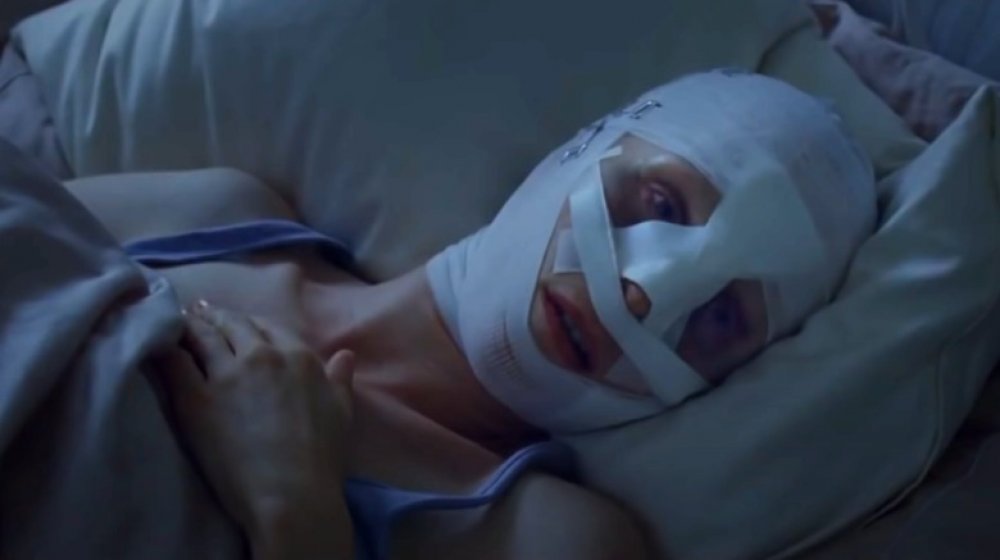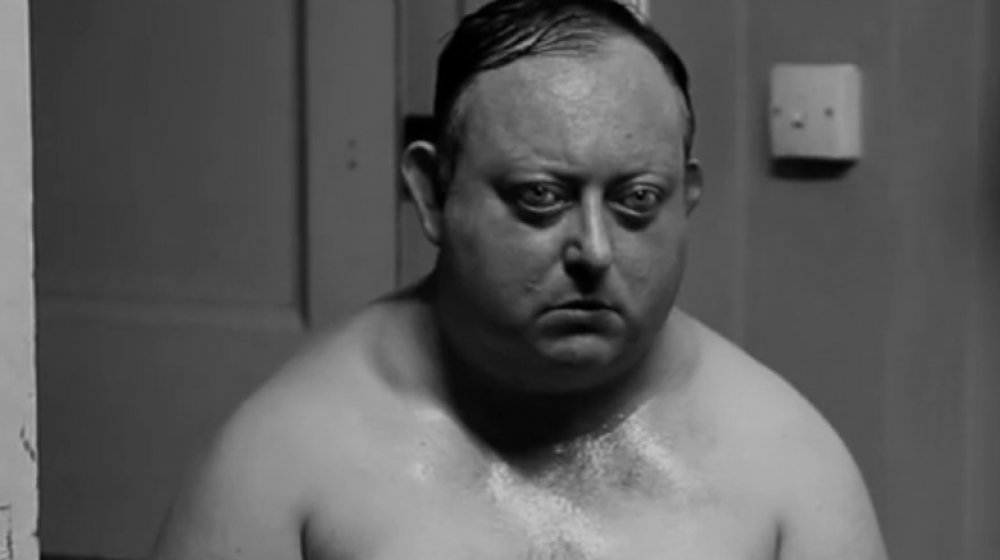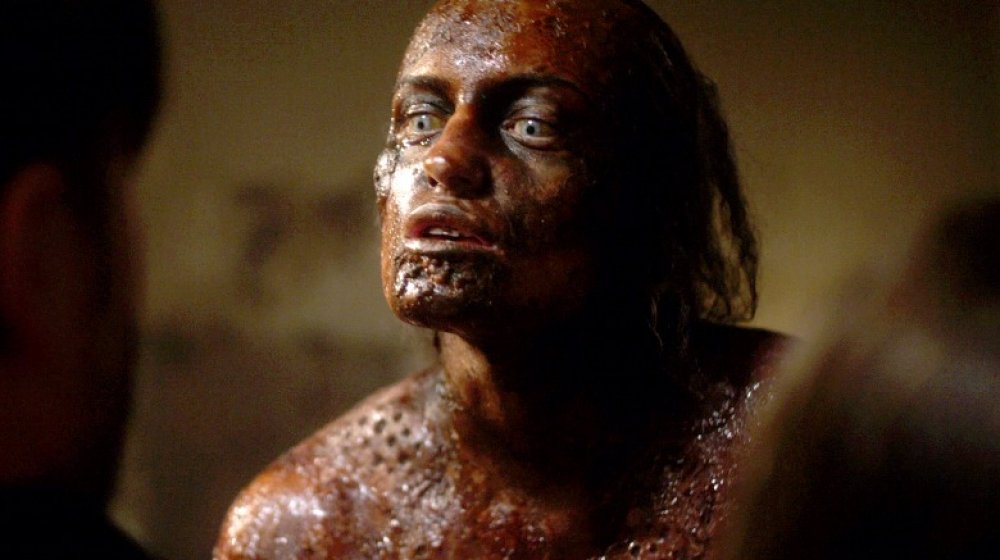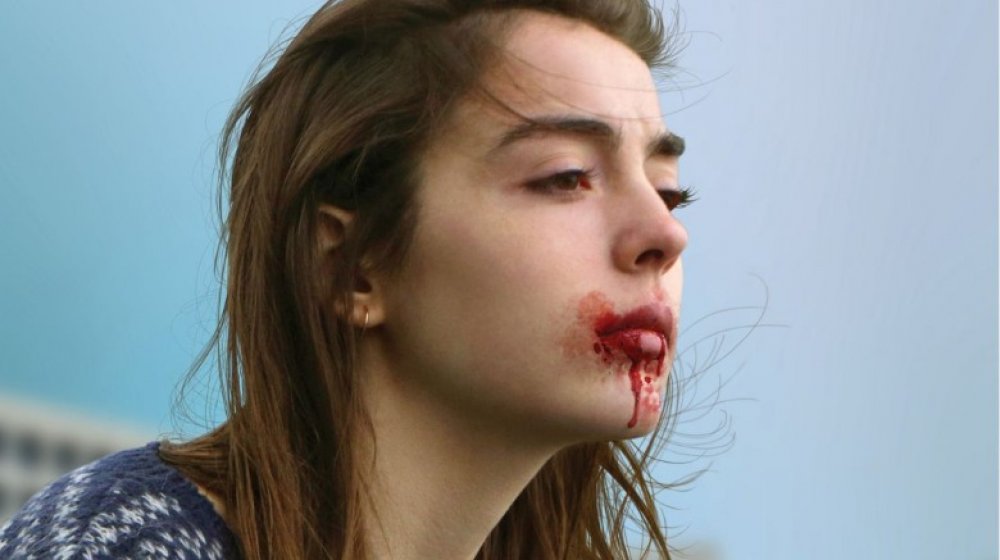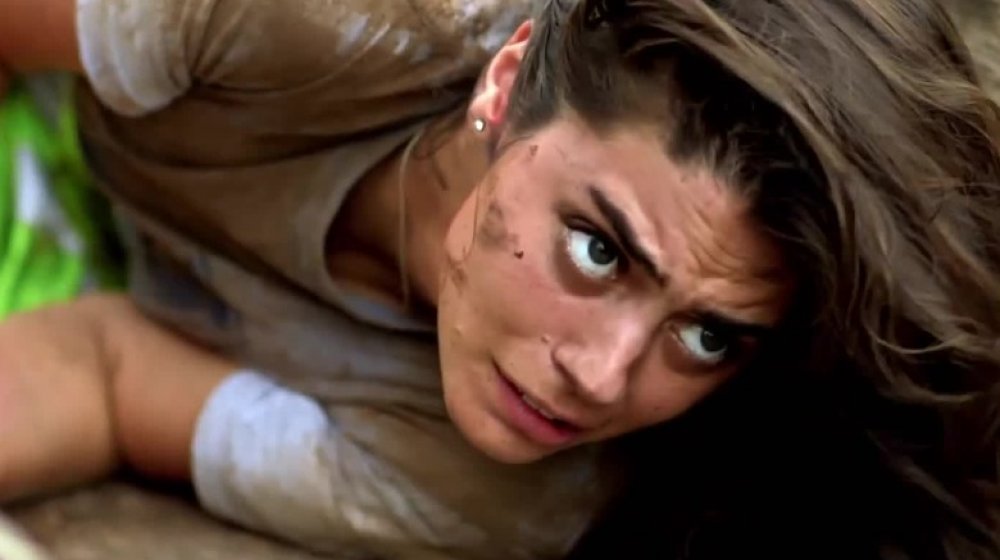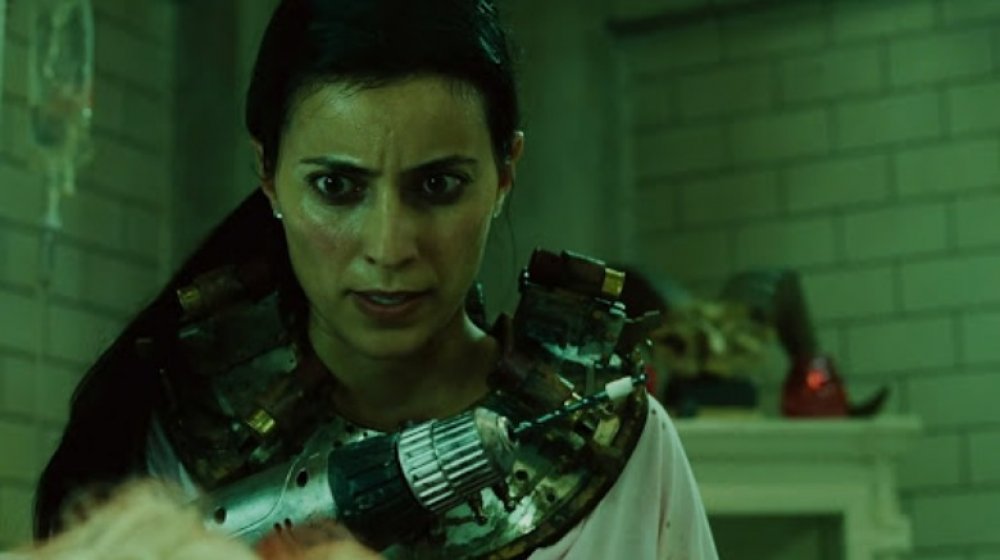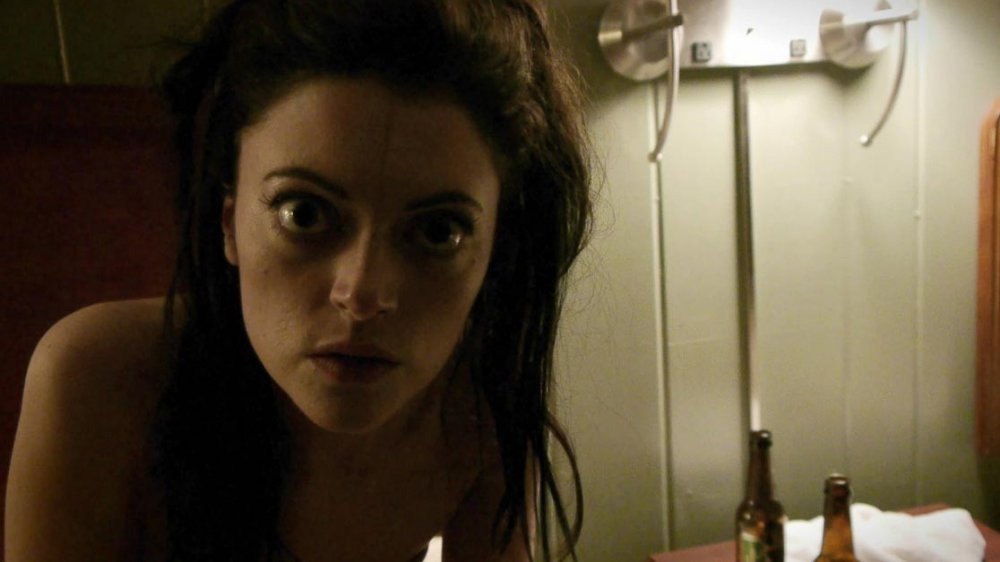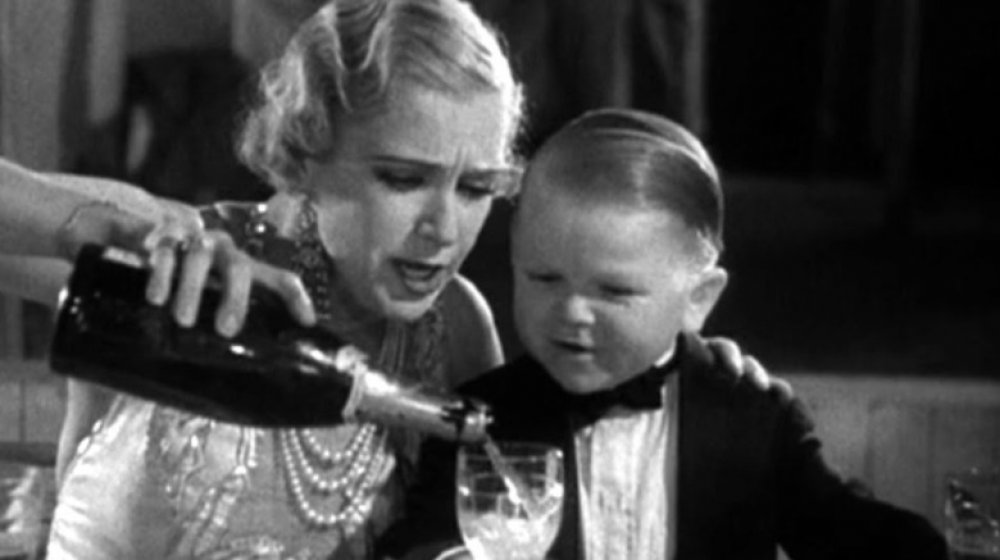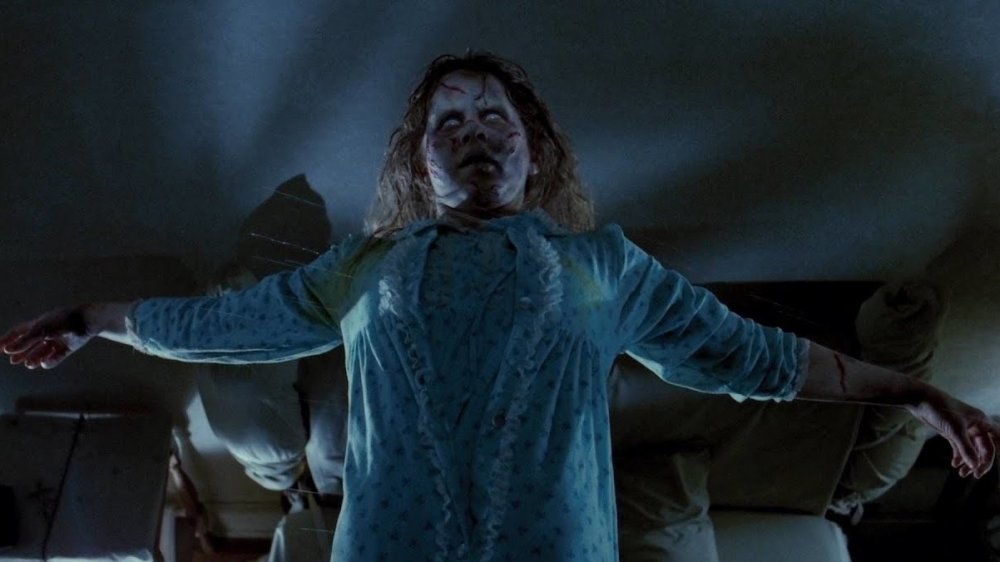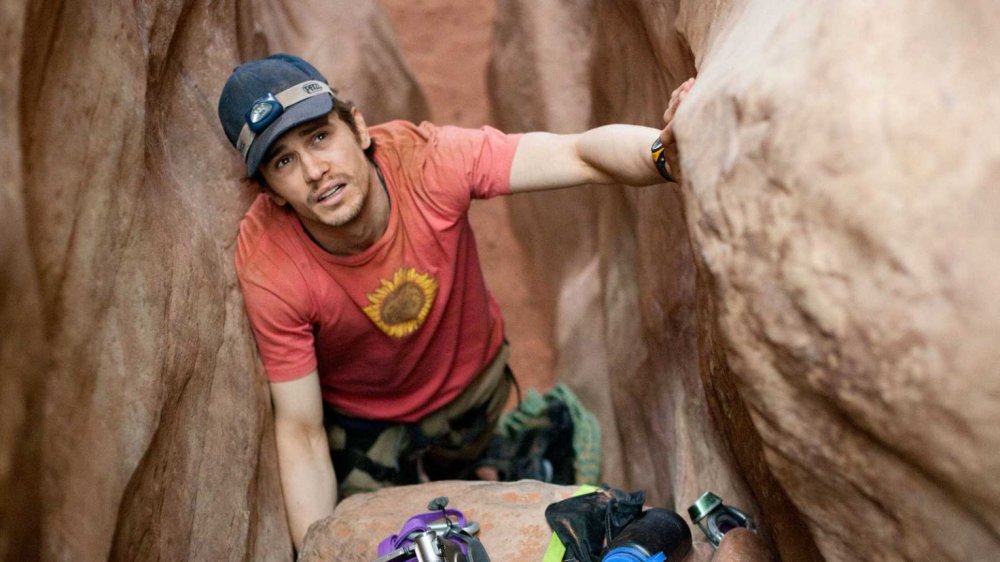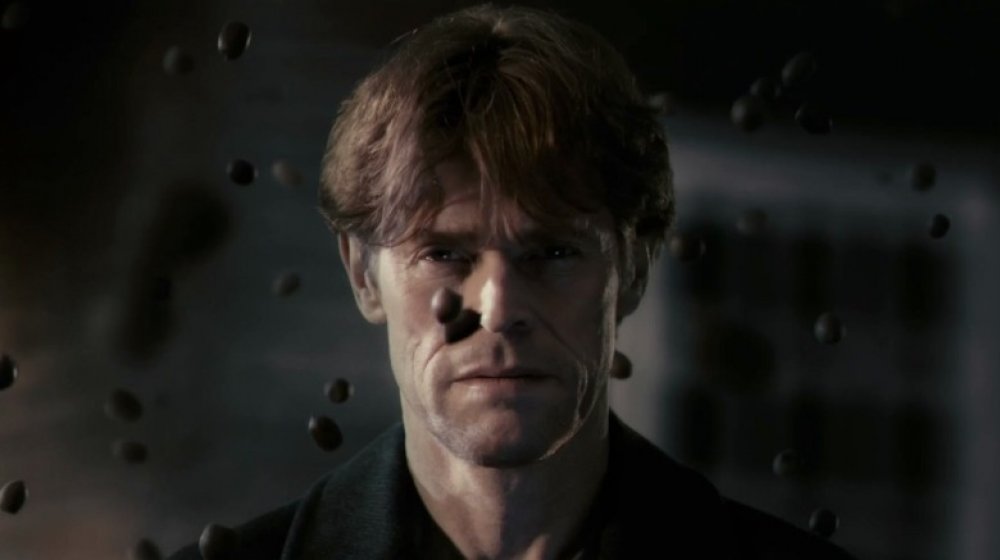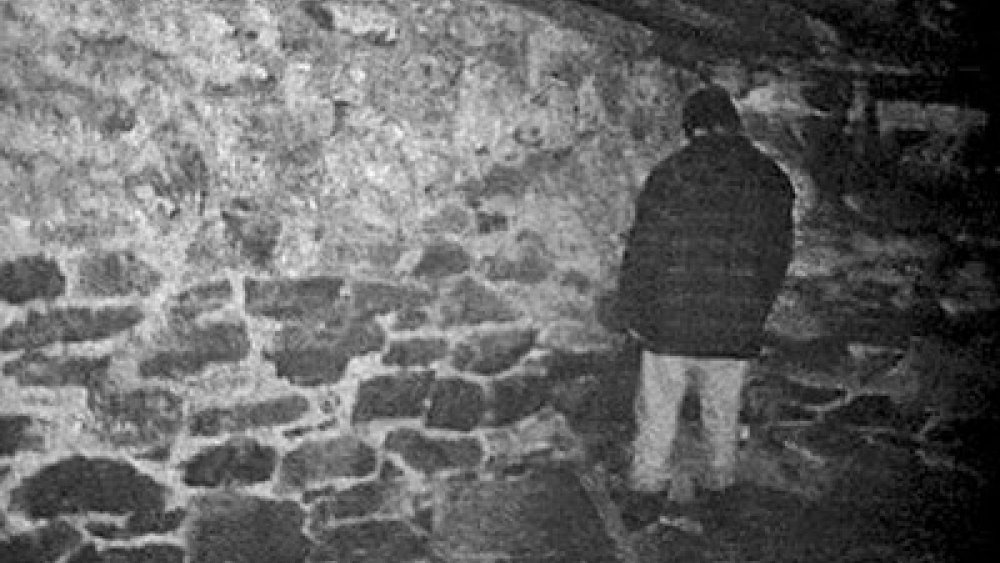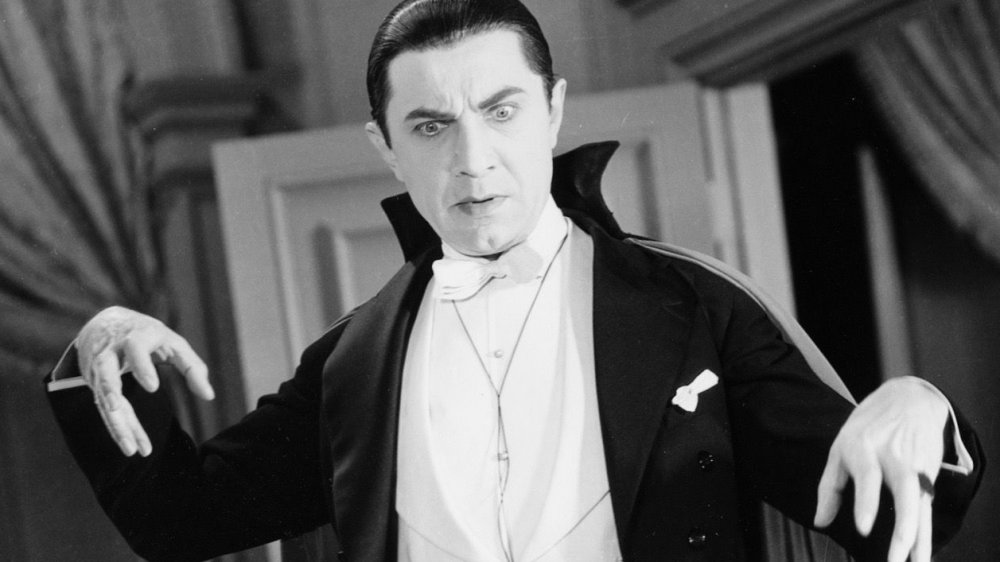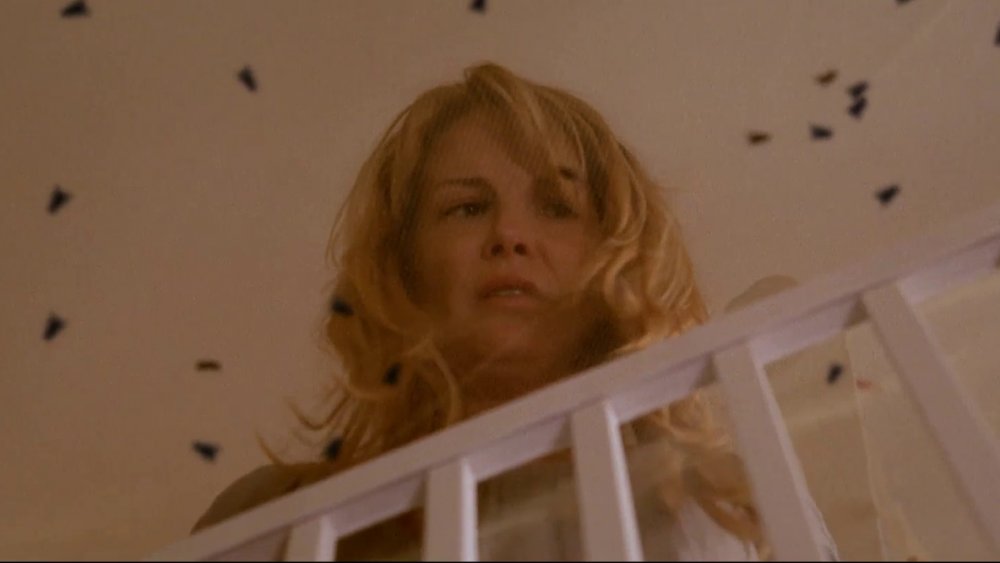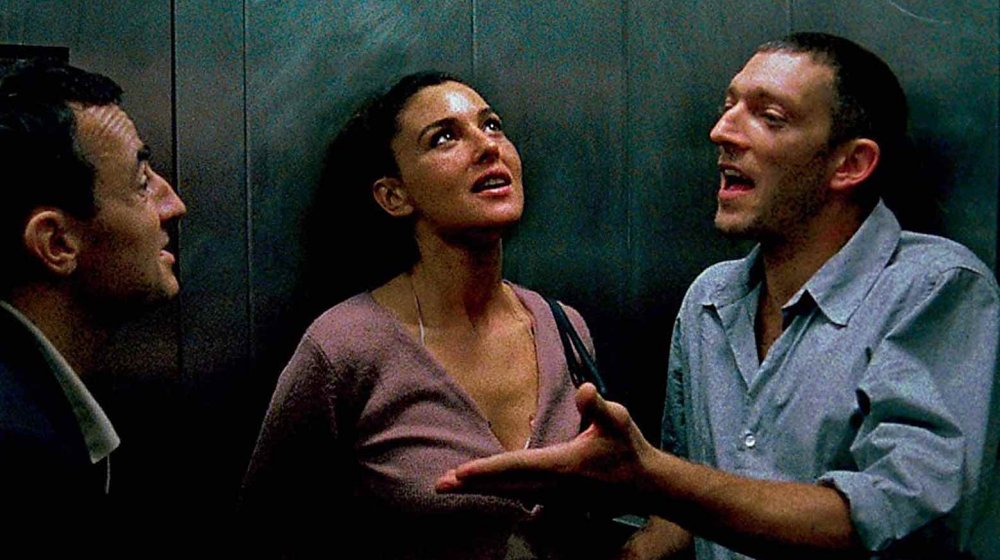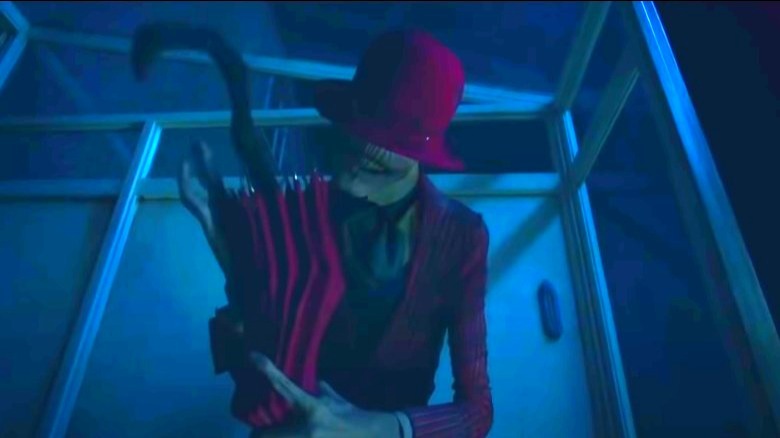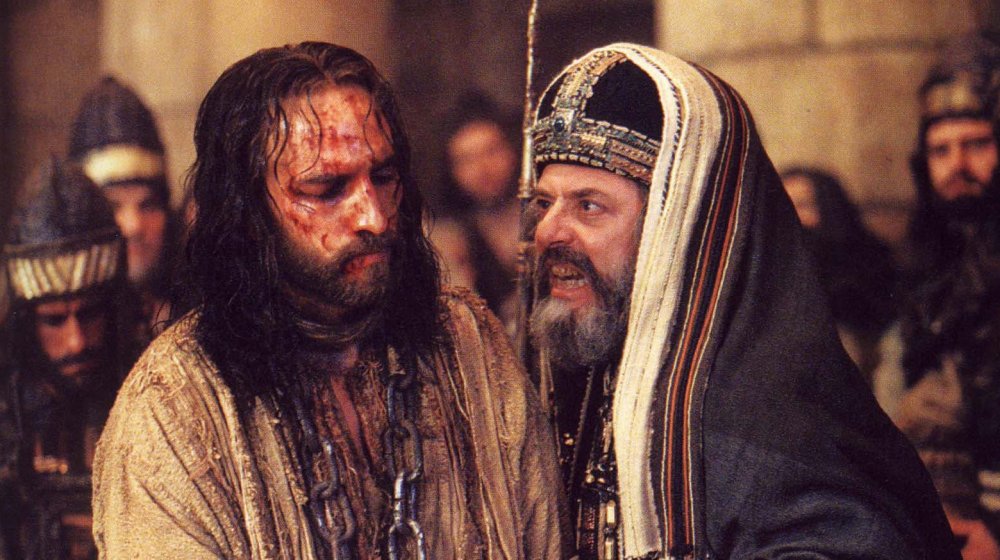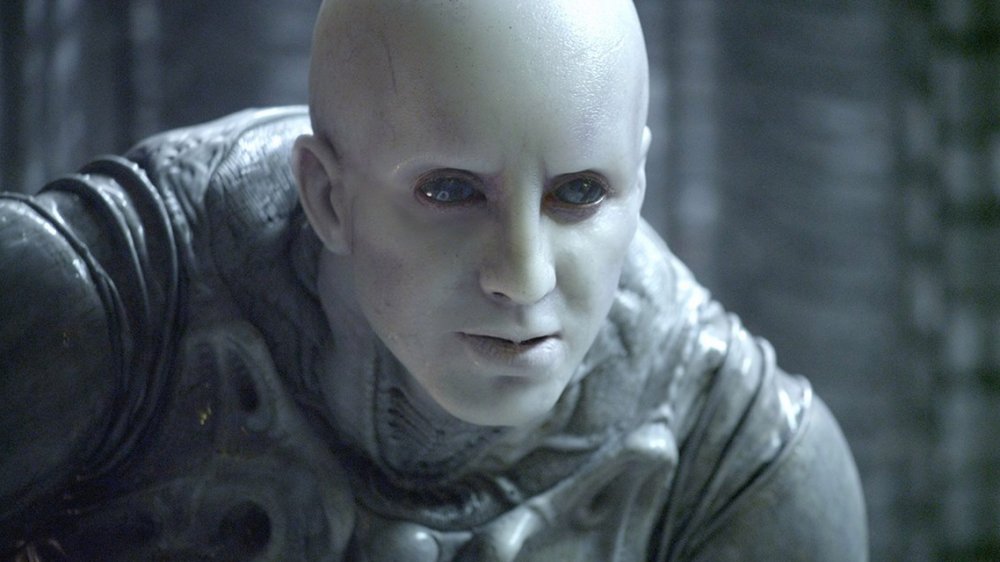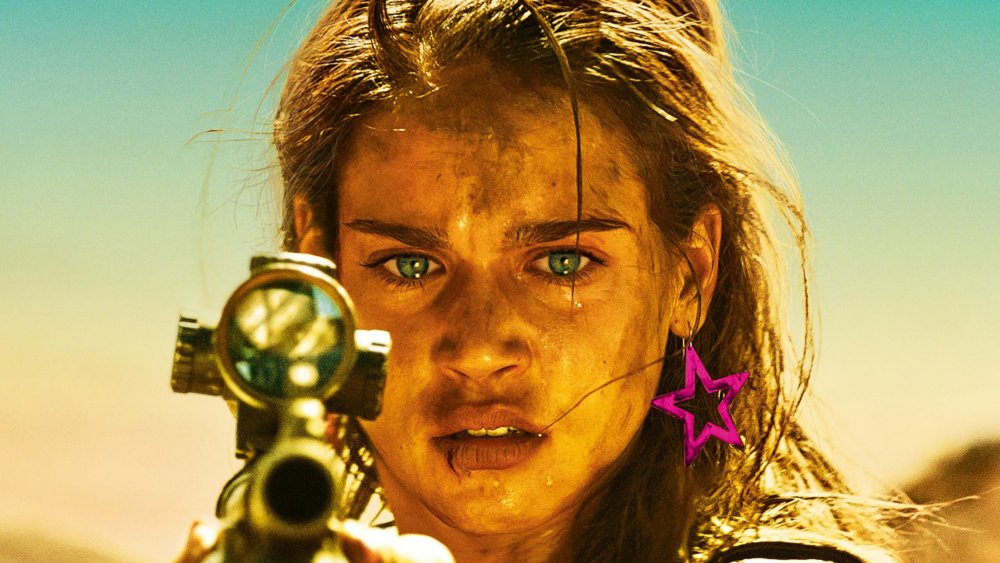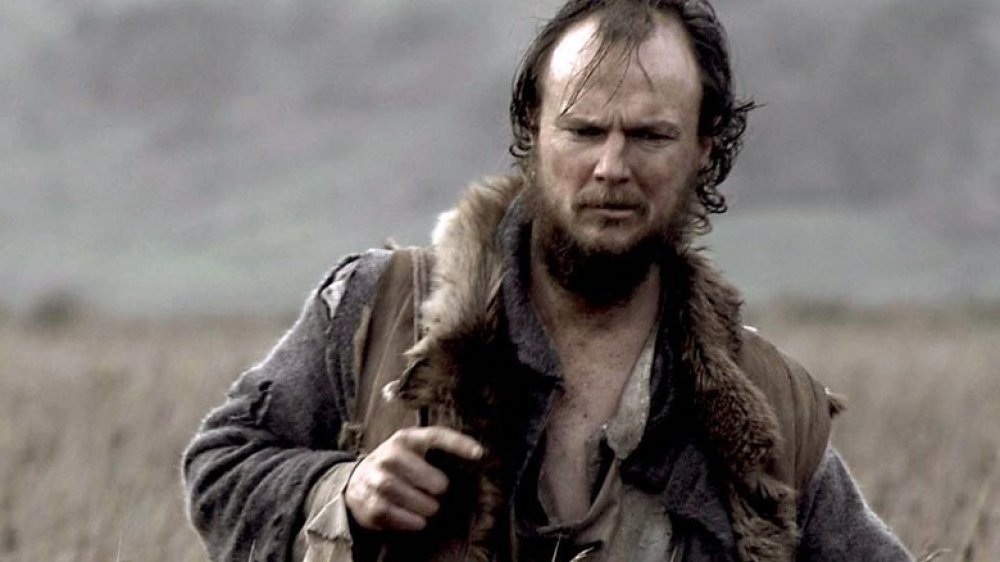Times Horror Movies Sent Someone To The Hospital
Horror films can get our adrenaline pumping, but sometimes, these thrills can get all too real. You sometimes hear a great new horror movie is sending folks to the hospital by scaring the bejeezus out of them and you wonder whether it really happened or if it's all just marketing. To help you figure it out, we've gathered some examples of times when horror movies actually prompted real-life medical attention.
Goodnight Mommy
Goodnight Mommy is an Austrian film from 2015 that about a pair of twin boys whose mother has just had facial reconstructive surgery. But once she comes home, all bandaged up, she seems to be a wholly different person and exudes a cold, severe aura. While the movie is mostly psychological horror, the latter half of the film is full of violence. According to Emily Buder of IndieWire, director Severin Fiala said, "Two people fainted. That's the best compliment we've had so far." As if the psychological terror wasn't enough, the violence just hammers the horror home.
The Human Centipede 2 (Full Sequence)
Speaking of disgusting body horror, did you know The Human Centipede 2 (Full Sequence) caused a woman to faint? Movieline's Jen Yamato wrote about her experience at the premiere at Fantastic Fest in 2011 and how festival founder Tim League joked about there being EMTs on hand in case people got sick. Though it was a joke, Yamato's seat buddy actually did faint and had to wait for paramedics after she came to. But what would you really expect from a sequel to The Human Centipede?
Bite
Have you ever heard the one about the woman who turned into an insect after getting bit by one? Well, that's the premise of the horror movie Bite. At its Fantasia International Film Festival premiere, moviegoers were given barf bags as a sort of gag but the joke was on the promoters, because some people actually had to make use of them. Jasmine Chung of First to Know said a few people even passed out, and an ambulance was called in for some of the audience members. We don't know firsthand how terribly gross this film is, but we'd recommend watching it on an empty stomach.
Raw
What goes with blood, guts, and gore? If you answered "fainting," you'd be correct. The cannibal film Raw premiered at the Toronto International Film Festival and apparently caused filmgoers to faint and vomit. Adam Gabbatt of the Guardian reported that paramedics had to be called in because some scenes featured realistic biting, lacerations, and wounds, and the sight was too much for audience members. If you're going to watch a movie that revolves around cannibalism, it's probably a safe bet that you're going to see some stuff that makes you queasy. Take our advice and don't make it part of a "dinner and a movie" date.
The Green Inferno
Another cannibal movie capable of getting folk to faint is Eli Roth's The Green Inferno, which featured a group of activists who crash their plane into a jungle and have to survive captivity at the hands of a cannibalistic tribe. Par for the course of a Roth movie, The Green Inferno is full of graphic images, gratuitous gore, and body mutilation. Oh, and the people-eating. Can't forget about the people-eating. An article on Newshub said a woman fainted during a screening of the film at the Deauville American Film Festival in France, and Roth retweeted the alert from the festival. Roth might consider a woman falling unconscious as a glowing review; we'll let you decide whether he's right.
Saw III
By the time we got around to Saw III, you'd have thought people would have built up a tolerance to all of the gross, violent images from the first two films. Obviously this was not the case, as the BBC reported that moviegoers at a UK theater fainted and emergency services were called out three times in one night because of the film. A woman in her 20s needed to be hospitalized, while others were treated at the scene. Apparently the film was just too much for them.
V/H/S
V/H/S is an anthology of scary stories that screened at the Sundance Film Festival in 2012—and certainly had an effect on viewers. According to Ellen Connolly and Mark Deull of Daily Mail, paramedics had to treat two audience members who suffered seizures and started vomiting . The film reportedly left one woman in tears the night before because of all of the suspense. Fortunately, none of these patrons had to be hospitalized.
Freaks
The 1932 classic Freaks is one of the original horror movies, released even before the Motion Production Code guidelines went into effect in 1934. As you can imagine from the title and the short clip of the intro, it centers on members of a carnival "freak show" in the early 1900s. According to John Patterson of the Guardian, the original test screening was so horrific that a woman claimed the film made her miscarry. Just imagine how people back then would react to some of the horror movies we have these days.
The Exorcist
If you've never seen The Exorcist, then you've probably never known true cinematic horror. This classic film based on William Peter Blatty's novel had quite an effect on people who saw it in the 1970s. Mike Vanderbilt of the A.V. Club wrote about a few YouTube clips touching on local news footage of audience reactions to the film, and an interview with a Westwood theater manager named Harry Francis discusses audience members fainting or crying. Considering that The Exorcist is a modern horror classic, we'd say that's par for the course.
127 Hours
While billed as a drama, 127 Hours quickly finds itself in survival horror movie territory when rock climber Aron Ralston (James Franco) falls down a crevice, his arm firmly trapped beneath a rock. Ralston didn't tell anybody where he was going, so his life was in his own hands. Literally. Using his rock climbing gear and a dull knife, Ralston was forced to break and then amputate his own arm and eventually walk himself to safety.
The self-amputation was so graphic that Movieline constructed an entire timeline of each incident where people got sick during screenings of Danny Boyle's 127 Hours around the world. At London Film Festival a number of attendees vomited and were taken to the hospital. A woman had a seizure while watching 127 Hours at a Producers Guild screening in Hollywood. And the Toronto Film Festival reported several fainters and one person who had a seizure. At Telluride Film Festival, one woman had a panic attack and another man fainted; both were taken to the hospital. But luckily nothing needed to be amputated.
Antichrist
After their child falls from a window to his death due to their negligence, She (Charlotte Gainsbourg) and He (Willem Dafoe) escape the city to a secluded cabin in the woods in order to help her deal with her grief. He is a psychotherapist, and, against all ethics, begins treating his wife and her various foundational traumas. The second installment in Lars Von Trier's Depression Trilogy, Antichrist is infused with a variety of grotesque imagery, including a deer with a stillborn doe hanging out of its belly and a fox that guts itself. The film is also filled with violent and sadistic sex scenes as She and He process the death of their son and their role in it.
But arguably the most disturbing scene is when She takes a pair of scissors to her own genitals and cuts herself, the event taking place in full sight on screen. The scene is so shocking and unholy that people got sick during screenings of Antichrist, while several people walked out of the theater during the film's premiere at Cannes. If the devil is in the details, this film is an antichrist, indeed.
The Blair Witch Project
In the movie that started the handheld camera and found footage horror movie sub-genre, three young film students are out in the woods around Burkittsville, Maryland to investigate the mysterious Blair Witch. At first it's all fun and games for Heather (Heather Donahue), Josh (Joshua Leonard), and Mike (Michael C. Williams) as they interview locals about the Blair Witch legend as well as Rustin Parr, a man who lived in the woods who kidnapped and killed children in pairs. But the documentary quickly turns into survival horror as the three youngsters find themselves set upon by dark forces each night, leading up to The Blair Witch Project's horrifying conclusion.
Unlike some of the other films in this list, it wasn't on-screen gore or violence that made audiences sick while watching The Blair Witch Project. Using handheld Super-8 and 16mm cameras, audiences got motion sickness from the jerky and all-too-realistic filming style that caused people to throw up. The problem was so bad and so quickly that cinemas were forced to include a warning about the movie before people went to see it. But people getting sick did not deter audiences from seeing the movie, making it one of the cheapest films to make and one of the most profitable films of all time after its release.
Dracula (1931)
By today's standards, Tod Browning's 1931 adaptation of Dracula seems positively tame. There is no sex, no nudity, no outrageous violence, and only the hint of gore. But back in the early days of cinema, this story about young John Harker (David Manners) journeying to meet Transylvanian Count Dracula (Bela Lugosi) in order to sell him property in London absolutely shocked audiences. In particular, the thrall that Dracula uses on women in order to subdue and then bite them had women swooning in the audience. Not that kind of swoon, the kind where they got dizzy and fainted.
Part of this was because at that time nobody had seen anything quite like Dracula, at least until Browning's 1932 film Freaks the next year, and it sent women in particular into a tizzy. The Count's smoldering good looks paired with his nocturnal visits to Lucy's (Frances Dade) and Mina's (Helen Chandler) bedrooms was just too much for the ladies of high society. It was absolutely scandalous, and they had to be carried out of the theater.
Grace
In a tale of gruesome parental loss, Madeline (Jordan Ladd) and Michael (Stephen Park) are in a car accident that takes the life of Michael and her unborn baby, Grace. Madeline's way to cope with the grief is to carry her baby to term anyway, against medical recommendations. Within minutes of being born, the stillborn baby seems to revive, but with a taste for blood rather than mother's milk. The child attracts putrid flies and cannot tolerate water, bleeding when Madeline tries to bathe her. The situation gets progressively worse in this heavy metaphor for postpartum depression and psychosis.
It's not often that a horror movie makes evil villains out of a baby. There's is something profoundly unnatural about the notion that makes this subject matter hard to touch. So it's no surprise that people would faint at Grace's premiere in Sundance due to the graphic nature of the baby's violence on screen, particularly when she goes from drinking her mother's blood to literally devouring her mom's flesh. Talk about biting the hand that feeds you.
Irreversible
In Gaspar Noe's brutal revenge film Irreversible, we follow Marcus (Vincent Cassell) and Pierre (Albert Dupontel) as they wreak violence around Paris in search of the man who horrifically assaulted Alex (Monica Belucci), their girlfriend and ex-girlfriend respectively. The film takes place in reverse chronological order, which makes it surprisingly unsatisfying for a revenge narrative. The avenging takes place before we properly know what happened, so in some ways Irreversible ends up being a rather anticlimactic revenge film. That's a point that Roger Ebert counters, explaining that showing the revenge first gives the viewer an opportunity to consider the assault without a context, or the ability to blame the victim as so many would've. Well, for those who saw it all the way through, that is.
Noe purposefully created the film's score using low-frequency sound waves to unsettle the viewer from the inside out. The brutal 10-minute single-camera and one-take rape and beating scene sent 250 people walking out of the cinema at the film's 2003 premiere at Cannes, 20 of them requiring oxygen and medical attention after collapsing. It is easily one of the most brutal and unflinching scenes of this type ever put on film, in particular because Alex fights her attacker the entire time. The scenes of Marcus and Pierre's revenge are also ultra-violent, befitting the original crime that inspired them.
The Conjuring 2
This incident is actually the most hardcore—and probably one of the strangest. According to Adam Boult of the Daily Telegraph, a 65-year-old man from Andhra Pradesh, India died after attending a screening of The Conjuring 2 at the Sri Balasubramaniar Cinema in the town of Tiruvannamalai. He was reported to have been suffering from chest pains towards the end of the movie, fainted, and was then pronounced dead after he was taken to Old Government Hospital. Now, dying at the end of a film is pretty strange already, but apparently the man's body—and the person in charge of handling it—both disappeared. This kind of thing might not be the best marketing, especially for the more superstitious among us.
The Passion of the Christ
One horror movie that sent someone to the hospital was Mel Gibson's 2004 The Passion of the Christ. And yes, the events leading up to Christ's crucifixtion takes this movie from historical period piece to torture porn horror as quick as you can say the Lord's Prayer. This Aramaic-language bio-pic tracks Jesus (Jim Caviezel) from the night before he is arrested and subsequently viciously beaten, whipped, and otherwise tortured over his religious beliefs, culminating in a crown of thorns forced onto his head as he carries the cross on which he will be nailed up a hill.
The events are so graphic and gruesome, with rivers of Jesus' blood trickling down all over the place, that a Kansas woman actually had a heart attack during his crucifixion and later died in the hospital. A Brazilian preacher who bought out a showing of The Passion of the Christ for members of his congregation also had a heart attack and died during the screening. The level of violence depicted on screen in the movie continues to divide audiences and critics alike.
Prometheus
In Ridley Scott's Alien prequel Prometheus, Dr. Elizabeth Shaw (Noomi Rapace) teams up with the Weyland Corporation and the crew of the Prometheus spacecraft to travel to the far reaches of the galaxy in order to locate who she calls "The Engineers," who she believes created the Human race. What they find is the same site we saw in James Cameron's Aliens, but years before that film took place and with a differently evolved Xenomorph creature than in the original films. Dr. Shaw is impregnated with a Xenomorph by power hungry android David (Michael Fassbender) who intends to breed an army that he can rule over. Once Dr. Shaw realizes what's growing inside her, she finds a surgical bay to remove it in what is a staggeringly gruesome extraction from her belly. She staples herself up and goes on to survive much more violence, including kicks to her raw wound.
This scene proved too intense for some viewers. One man claimed to have passed out for a full five minutes while his panicked girlfriend called for help, according to Escapist Magazine. Meanwhile, a teenage boy in Australia was rushed to the hospital after having an epileptic seizure during this self-imposed cesarean section. It's almost funny it was men who passed out during this scene. Women are like, "Pshaw. My monthly cramps are worse than that."
Revenge
Coralie Fargeat's breakout feminist horror film, Revenge, also sent a viewer to the hospital after having a seizure. Revenge finds us in a remote desert hideaway in the American southwest where Jen (Matilda Lutz) is having a romantic weekend getaway with her married lover Richard (Kevin Janssens). That is, until Richard's oafish friends show up unannounced and become obsessed with young Jen. Stan (Vincent Colombe) reads Jen's flirtations as something more than politeness, and when she tells him explicitly she is not interested, he rapes her. In an excellent example of the female gaze, the assault takes place off camera so this scene isn't what provoked the seizure in the Revenge audience.
When the men realize that Jen could threaten their entire worlds by reporting the assault to the police, they throw her over a cliff and leave her for dead. She survives and proceeds to hunt down the men who are now out in the wild, hunting. Jen sets a booby trap for Stan that he literally steps right into. An enormous piece of glass lodges in the bottom of his bare foot, and he proceeds to pull it out. This grotesque scene proved too much for one man at the Midnight Madness premiere of Revenge at the Toronto International Film Festival. He had an epileptic seizure and paramedics had to take him to the hospital.
Van Diemen's Land
In 2009, Australian film director Jonathan Auf Der Heide released his film Van Diemen's Land based on the actual history of the island of Tasmania, which was used as a European prison colony beginning in the early 1800s. The film features a group of prisoners in 1822 who break out of the prison and land in the Tasmanian wilderness, only to be forced to cannibalize each other since they have no survival skills. Sarah Island is known for its variety of natural barriers, like unforgiving rock passes and wild bodies of water that made the remote site perfect for a prison. Infamous "cannibal convict" Alexander Pearce — played here by Oscar Redding — was the only survivor both in the film and in reality.
The idea of cannibalism generally makes even the strongest stomach queasy. But the graphic depictions in Auf Der Heide's film were so much that two people at a screening in New Zealand found themselves throwing up in the aisles. Auf Der Heide also noted that several people fainted during the first killing scene, which surprised him since he felt he had taken an understated and almost gothic approach to the violence on screen as well as the source material it was based on. It just goes to show that no matter how artfully you might present horrors like cannibalism on screen, it's still going to make people hurl just from the thought of it.
